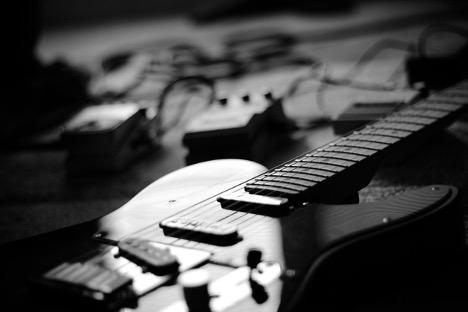When practicing guitar, players tend to stick to only one amp setting, depending on what technique they’re working on. For example, using a high gain setting when practicing alternate picking.
Sticking to only one setting when practicing anything on the guitar can be detrimental to your progress because it can potentially mask or cover up certain inefficiencies in your playing or technique. You might think that your playing is clean when in actual fact the reason why your playing sounds clean could be attributed to the amp setting you are using.
Therefore, with anything you practice, be sure to practice on a clean setting, distorted setting and unplugged. Your playing should be consistent no matter which setting you use.
Practicing clean
Practicing on a clean setting is a great way to gauge the cleanness of your playing. A heavily distorted setting compresses the signal of your guitar, making each note ring out at more or less the same volume. This makes it difficult to gauge the articulation of each note. On a clean setting, the signal is more responsive and the dynamics (difference in volume) of each note is more apparent. For example, if you are working on legato using a distorted setting, simply removing your finger from a string would mimic the sound of an actual pull off. This might give you the impression that you are performing the correct technique while in actual fact the sound is produced by the setting on the amp, not proper technique. If you perform the same motion of simply removing your finger from a string on a clean setting, the difference in volume and articulation of the final note is much more apparent. Therefore you cannot get away with poor form. The notes can only be produced with a proper pull off.
For picking practice on a clean setting, try to change how hard you pick each note. Start by picking as lightly as possible and gradually increase how hard you pick each note. At each dynamic level, make sure the volume of each note is consistent throughout every string while keeping how hard you pick those notes the same. Working on dynamics this way is great and allows you to vary how hard you pick the notes on the guitar depending on the level of intensity you wish to project through your playing.
Practicing with distortion
Practicing with distortion is equally important as practicing on a clean setting. It exposes its own set of potential inefficiencies and poor form as opposed to playing clean.
With a clean setting, unwanted string noise from the lack of proper muting technique isn’t very obvious. A gain or distorted setting amplifies unwanted string noise, making it easier to focus on specific areas of fretting and picking hand string muting.
Another great way that practicing with a distorted setting is with sweep picking, specifically for finger rolling technique and notes bleeding together. When two notes are ringing out together on a clean setting, both notes ring out relatively clearly compared to if they ring out on a high gain setting. Practicing with distortion allows you to focus on the cleanness of each note, making sure that only one note is ringing out at any given time and all other strings are being properly muted, since the bleeding between notes are very obvious and often sounds unpleasant.
Practicing unplugged
Practicing unplugged also comes with its own set of benefits. The amp itself makes whatever you play on the guitar louder. This can potentially give you a false sense of how articulate each note actually is when you play them. When practicing unplugged, you want to make sure that the notes are still articulate and loud enough to be heard even without an amp. You can work on absolutely any technique unplugged.
Be aware that each of these methods of practice covers up different potential weaknesses of your technique. Therefore it is crucial that you work on all three ways of practicing to ensure that no inefficiency or poor form in your playing goes unnoticed. With whatever you are working on, split your time evenly between playing clean, with distortion and unplugged. Apply these approaches and you are guaranteed to see huge leaps in your playing and technique!
Learning to play guitar on your own can be frustrating and challenging, especially if you don’t know what to do. Having a great teacher makes the whole process more fun, enjoyable and gets you real results fast.
Learning to play guitar on your own can be frustrating and challenging, especially if you don’t know what to do. Having a great teacher makes the whole process more fun, enjoyable and gets you real results fast.
Solve your guitar-related problems at GuitarKL, in Kuala Lumpur, MALAYSIA. Visit https://guitarkl.com to become an awesome guitar player.
